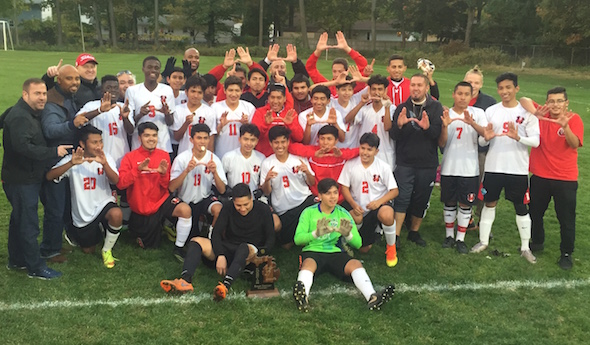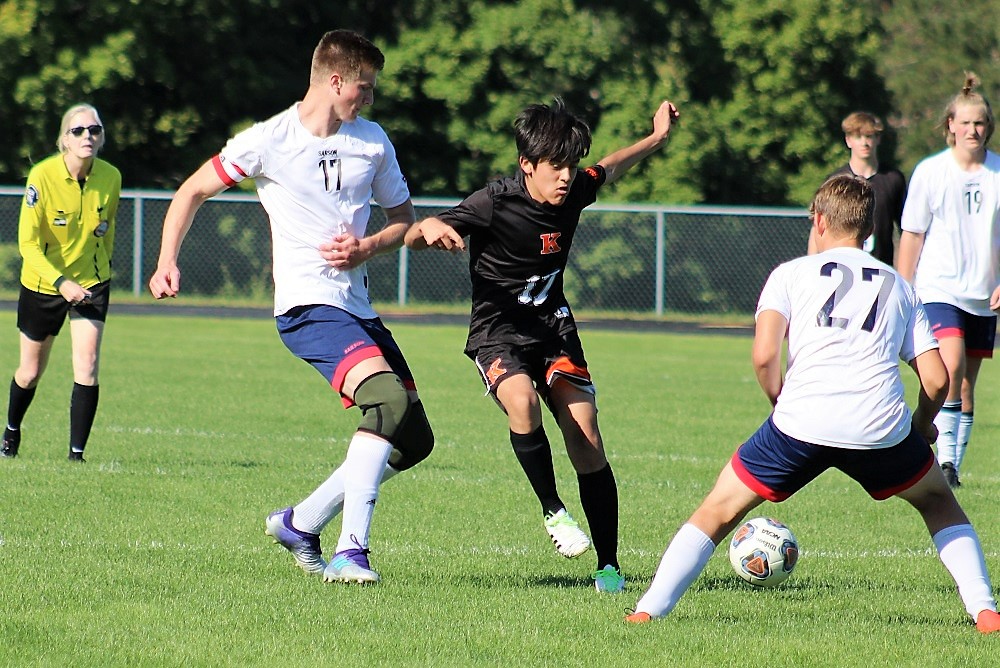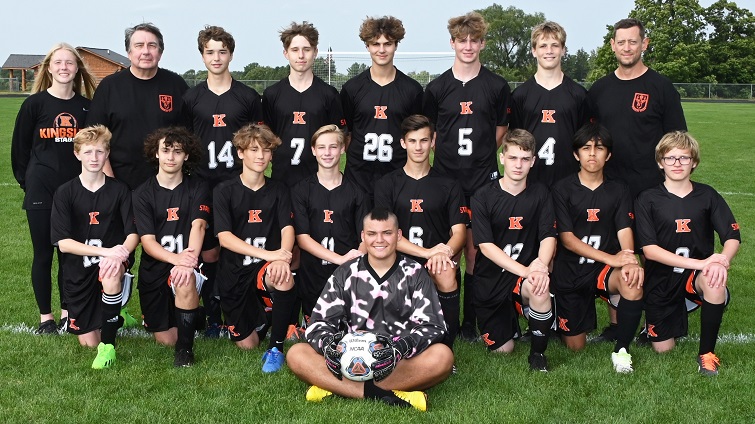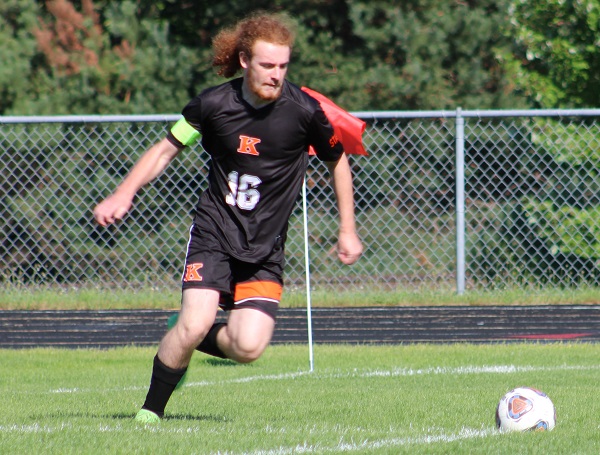
Amid Challenges, Union Enjoys Trophy Run
December 2, 2016
By Ryan Portenga
Muskegon Mona Shores athletic director
The last time Grand Rapids Union High School hoisted a postseason tournament trophy was Saturday, June 4, 2002 – when the Red Hawks' baseball team clinched a Michigan High School Athletic Association District championship.
Despite fielding more than 20 varsity sports, the school – nestled among the northwestern city neighborhoods of Grand Rapids – had since struggled in varsity competition more than it succeeded as the seasons passed by.
When the historic City League of Grand Rapids (founded in 1928) folded following the 2007-08 school year – leading to Union's entrance into the larger Ottawa-Kent Conference of West Michigan – there was reason for optimism within the school's extra-curricular programming. Regardless of how loyalists and stakeholders felt about changes to issues such as organizational bylaws, conference leadership and divisional alignment, the conference shift triggered something of a fresh start.
Yet, since then, the number of eligible athletes within Grand Rapids Public Schools' senior highs has shrunk from 4,500+ (2008-09) to 3,000+ (2016-17), and two of the city's public high schools which joined the Ottawa-Kent Conference with Union (Central and Creston) have ceased traditional operations and nixed athletic programming. Furthermore, Union's football program – the sport traditionally drawing the most community support – has sported a record of 6-74 since the switch in leagues.
Describing such lack of athletic success as a "drought" might be an understatement.
To therefore face a second-half deficit of two goals against five-time reigning District champion Grand Haven in this year's Division 1 District tournament seemed more ordinary than extraordinary. However, with Juan Zavala – the team's fiery first-year head coach – and senior goalkeeper Jesus Ramirez encouraging the Red Hawks from opposite ends of the pitch, the extraordinary happened.
The game's box score would show that Union's comeback began in the 52nd minute when forward Gustavo Lopez netted a rebound to cut the Buccaneers' lead in half. Yet, it was easy to sense a shift in momentum each time the Red Hawks gained possession – driving deeper into Grand Haven's defense with each touch. Then, with just a handful of minutes left in the tilt – after each team whiffed on a barrage of scoring opportunities – midfielder Serge Mwembo converted a free kick ricochet sent in from more than 20 yards out from teammate Cristian Madrigal to tie the match ... and jubilation ensued. Goliath had not yet fallen, but more than enough had been done to challenge the impossible.
See, even if their rally fell short and the boys were to lose, Union's resilience and transformation was inspiring. Unlike most schools they play, the Red Hawks' players are divided during the school day – with 13 attending Union High School and seven attending City High a few miles away downtown – making practices difficult to organize and administer. Then consider the fact that 19 of their 21 athletes are native Spanish-speaking student-athletes – making communication tough between opponents and officials at times.
Finally, while once plagued by an egregious episode from just a few short years before – when one of its players struck an official in the face after receiving a red card – this season’s team had amassed only a handful of yellow cards all season and no red cards. Sure, Union enjoyed a nice following of fans, but there also were plenty of others (perhaps unbeknownst to the team) rooting them on.
"Sure, our team faces challenges," Zavala admits, "but their approach has been nothing short of inspiring. Just like we enjoy maintaining possession and attacking our opponents on the field, we like to attack obstacles off of the field as well."
Although plenty was overcome off of the field and within the culture of the program, an on-field obstacle reared its head as the season came to a close ... the team was having trouble scoring. During the final week of regular-season play, Union dropped a game 2-0 to league foe Muskegon Mona Shores and then lost to eventual conference champion Jenison, 3-0.
Although some of the offensive woes were due to injuries, there was plenty to worry about heading into the District tournament.
"Our kids are resilient," the rookie head coach explained. "They know that our program has fallen short in past years, but they also understand their potential and capabilities. Even though we faltered a bit at the end of the season, we entered the tournament with high expectations."
High expectations that had now come down to penalty kicks after two scoreless 10-minute overtime sessions against a program from Grand Haven that hadn't lost a District championship game in half a decade.
"Unlike past years where heads have dropped and attitudes would get the better of us in such situations, our kids embraced the opportunity," Zavala continued.
Rafa Paz (the team's incredible talented junior midfielder), Luis Madrigal, and Gustavo Perez each scored to open the penalty kick session. Then, not only did goalie Jesus Ramirez make a save, but the senior buried his shot in the back of the net to send the contest into a sudden-death shootout.
"I've walked our hallways," says Zavala, who played at both Union and nearby Kenowa Hills High School more than a decade ago when he was in school. "I know what our kids face, what they've gone through, facing the seemingly impossible at times. I wasn't even sure we would have a team or a program just a few months before – and here we are in a sudden-death shootout to win a District championship against a program like Grand Haven has. Win or lose, it had been an incredible journey with these boys."
Following an uncharacteristic Buccaneers miss in the sixth shot of the shootout, Union sophomore Wilson Rodas approached the ball amid an eerie silence surrounding the field – a silence that erupted into triumphant jubilation a split-second later as the soccer ball met the back of the net. After more than a decade without an addition, Union High School would now have a new "Mitten" for its trophy case back home on Tremont Boulevard.
"I'm still not sure what to think or how to react," concluded Zavala. "It is so difficult to describe that moment – when Rodas' shot slipped through to the net. I'm just so incredibly proud of our kids and happy for our community. This is why we do what we do... it's all for them. There is no substitute for high school sports."
Slaying Goliath does not happen every day or even very often – especially in high school sports. More often than not, the game within our games features the haves versus the have-nots. Yet, every so often – especially when David slays Goliath – we are reminded of all that is good and pure within our business ... the business of school communities, togetherness and defying overwhelming odds.
Union went on to fall, 4-0, to Traverse City West in their Division 1 Regional Semifinal.
PHOTO: Grand Rapids Union celebrates the school’s first District championship in any sport since 2002. (Photo courtesy of Ryan Portenga.)

Records May Not Show It - Yet - But Kingsley Soccer Improving, Ready to Rise
By
Tom Spencer
Special for MHSAA.com
October 21, 2022
Kingsley did not go on unnoticed this fall in Northwest Conference soccer play.
 In fact, many took considerable notice of the Stags.
In fact, many took considerable notice of the Stags.
And, the coaches of the league’s top teams are looking for even bigger things ahead from Kingsley. Quite, frankly, they’re hoping it comes to fruition for their own teams’ sakes.
“It’s always beneficial to have a solid conference – as it helps teams prepare for playoffs,” said Rob Sirrine, coach of this year’s league title winner, Leland. “We expect them to improve in the next few years.
“Kingsley has had a rough go of it the last few years – not unlike other schools in our conference that also have football teams,” he continued. “I think they have some potential based on the coaches they have brought in and volunteers that are helping out the program.”
Second-year Kingsley head coach Tim VanWingerden welcomed Mike Alanson as a volunteer varsity assistant coach and two middle school coaches — Bert Baker and Lars Mitchell — this fall. Baker and Mitchell had kids on the Stags’ middle school squad this season.
League opponents, including the varsity coaches, noted big differences already.
Buckley coach John Vermilya, whose Bears finished second this year after winning the crown a year ago, echoed Sirrine.
“Kingsley has shown incredible resilience over the last three seasons,” Vermilya said. “This season they bounced back with an influx of young players, and you can see their growing tactical awareness along with technical ability.”
Youth soccer is growing in the Kingsley community as well, adding to the excitement. In fact, VanWindergen has two boys —Ted, 10, and Gunnar, 9, playing in the youth program. Tabatha VanWingerden, wife of the Stags’ head coach, is the coach of the U-12 team.
 Mitch Miggenburg, Kingsley’s athletic director, is pleased to see the growth in numbers as the Stags move through “a 3-5 year” plan to become more competitive in soccer and cross country. He’s hoping those sports can find success similar to that of the Stags’ football team.
Mitch Miggenburg, Kingsley’s athletic director, is pleased to see the growth in numbers as the Stags move through “a 3-5 year” plan to become more competitive in soccer and cross country. He’s hoping those sports can find success similar to that of the Stags’ football team.
Kingsley is 6-2 on the gridiron and looking ahead to the football playoffs again. The Stags are fielding a full squad of cross country runners this fall after some lean years.
With an enrollment of well under 500, Kingsley has been able to involve 62 boys in football, 10 in cross country and 17 in soccer. Miggenburg noted cuts had to be made to the school’s co-ed middle school team this fall.
“I think we’re headed in the right direction,” Miggenburg said. “If you look at our record, you might not see it.
“This is not something that is going to happen overnight,” he continued. “In order for us to develop the way we want to develop, we’ve got to put some time in outside the season. And we have some coaches willing to help and do that, and it will only benefit us in the future.”
The Stags have not won a game the last two seasons, but VanWingerden believes success, as defined by wins, is right around the corner. He knows his team has shown moments of brilliance in every contest before the goals mounted against the Stags.
VanWingerden and Kingsley have been praised for outstanding sportsmanship by referees, opposing players and coaches.
Other bright spots in 2022 included outstanding play by freshman goalie Nate Lamie and stellar defense by senior captain Zakkeus Bedford. The Stags will have to overcome the loss of Bedford, their only senior this year, who played with tremendous drive and was the leader on the field.
But, they should return rest of the squad hungry for wins. And, they’ll add some solid incoming freshman players.
 “I think next year is going to be a big turnaround,” VanWingerden predicted. “So the next two, three years, we’re going to start turning some heads.”
“I think next year is going to be a big turnaround,” VanWingerden predicted. “So the next two, three years, we’re going to start turning some heads.”
Despite not experiencing wins either of the last two seasons, the Stags have enjoyed playing soccer.
“There is a camaraderie there with these kids I just can’t quite put my finger on, but it’s part of what binds them better, facing that adversity on a regular basis and getting though it together as a team,” VanWingerden said. “They’ve come to practice the next day determined to work hard and try to improve little by little.
“The common goal to get better pulls them together and gives them a determination that is hard to find.”
Many conference games this year were played 9 vs. 9 or 10 vs. 10 per conference agreement. Benzie Central and Glen Lake played with fewer than 11 players in every contest this season. Benzie Central, Glen Lake, Kingsley and Suttons Bay all compete in cross country, football and soccer. Leland and Buckley do not field football squads.
The Comets won a District championship 1-0 on Thursday at Suttons Bay. The Bears are playing in a District Final on Saturday in Lakeview. Kingsley’s 0-19 season ended with a Division 3 District-opening loss to Boyne City last week.
The Stags have already begun working on next year. Offseason plans include drop-in soccer and participation in a newly-developed strength and conditioning program.
“The program is not going to move forward unless we put in a ton of work,” VanWingerden acknowledged. “We’ve had glimpses into what we could be if we did it on a regular basis.
“It is really encouraging.”
 Tom Spencer is a longtime MHSAA-registered basketball and soccer official, and former softball and baseball official, and he also has coached in the northern Lower Peninsula area. He previously has written for the Saginaw News, Bay County Sports Page and Midland Daily News. He can be reached at [email protected] with story ideas for Manistee, Wexford, Missaukee, Roscommon, Ogemaw, Iosco, Alcona, Oscoda, Crawford, Kalkaska, Grand Traverse, Benzie, Leelanau, Antrim, Otsego, Montmorency, Alpena, Presque Isle, Cheboygan, Charlevoix and Emmet counties.
Tom Spencer is a longtime MHSAA-registered basketball and soccer official, and former softball and baseball official, and he also has coached in the northern Lower Peninsula area. He previously has written for the Saginaw News, Bay County Sports Page and Midland Daily News. He can be reached at [email protected] with story ideas for Manistee, Wexford, Missaukee, Roscommon, Ogemaw, Iosco, Alcona, Oscoda, Crawford, Kalkaska, Grand Traverse, Benzie, Leelanau, Antrim, Otsego, Montmorency, Alpena, Presque Isle, Cheboygan, Charlevoix and Emmet counties.
PHOTOS (Top) Kingsley’s Rolando Torres works to gain possession against Traverse City Bulldogs’ Tyler Ritola (17), Jonathon Scott (27) and Syrus Ritola (19), as Josephine Arrowood officiates. (Middle) This fall’s Kingsley soccer team. (Below) Zakkeus Bedford lines up a kick this season. (Photos courtesy of the Kingsley athletic department.)

